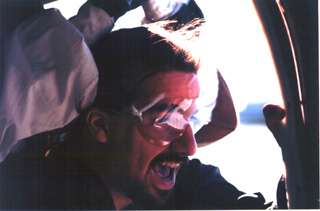


My second jump would be just one week later, on May 16th. I wish I would have written this sooner, it’s been 4 months since those jumps. In my mind, they all pretty much ran together, and were very similar to my first jump, except I wasn’t as nervous, and actually by the 4th jump, I was just wanting to hurry up and get it done! I wanted to have my own gear, and get rid of that horrible opening shock! I guess I never did explain what a tandem jump was. On a tandem jump, you have a tandem master, he is the one wearing the parachute. It’s specifically designed for 2 people, so don’t worry. The tandem passenger wears a harness that the back hooks into the front of the tandem master’s harness. Get the picture? It’s very akward to move, and the harness dug into my legs a little at opening, but it’s a great way to get introduced to skydiving! You don’t have the pressures of the AFF system where you have to learn everything there is to learn for that first jump; and it’s better than static line because you freefall on your first jump! That’s my opinion for what it’s worth… back to the story!

Balki prepares to exit on his 2nd tandem
For my second jump, Randy was my tandem master (same guy Balki had his first jump). You can tell Randy loves what he does! He can just talk to you about skydiving, and his excitement is contagious! I remember when we opened on that second jump, he was hootin’ and hollarin’ like it was his first jump! If I remember right, that second jump we did a few turns, and I pulled the ripcord (well, ok, I kinda missed it… I was supposed to pull it). I didn’t feel so bad that I missed it. Randy said it wasn’t anything to worry about, we did great other than that, just get it on the next two jumps, and even then it really didn’t matter, because once you were done with tandems, there’s no more ripcord, you move to a BOC deployment method (BOC Stands for Bottom Of Container – the pilot chute is in a pouch at the bottom of the container, you pull it out with your hand). And I really didn’t feel so bad after talking to Jon, he had pulled it a half second after the tandem master pulled his (the TM has his own ripcord he can pull) and then dropped the ripcord! So, he had to pay $6 to replace it.
My third jump was on June 6th. My tandem master for this jump (and my 4th) would be Gary Arnold. Gary was an awesome TM also. You could tell he had a great time doing tandems, and he is a very skilled skydiver as well as a good instructor. I learned a lot about canopy control and finding my way back to the drop zone by using landmarks. For those who have never looked at a familiar area from 4,000 feet above it, trust me, it looks completely different. It’s not as easy as it may sound to find where you want to go when you’re first getting started. Of course, after a few jumps, you know the area like your own backyard. The maneuvers for my third and forth jumps were just simple forward and backward movement. The TM does most of the work, but I think it’s more so the student gets an idea of what he/she is supposed to do, and how it’s supposed to feel. I’m also happy to report that I found and pulled the ripcord at the appropriate altitude and held onto it for my last two tandems!
Balki fell a little behind Jon and I in the student program. This is not an inexpensive sport! He had other matters that required his wallet's attention. He finally got his second tandem on July 18, by which time Jon and I were done with the tandems, and moved onto the IAF Phase of the training.

Jon (left) and Balki (right) holding their logbooks after 1st jump
Understand yet why his nickname is 'Balki'?